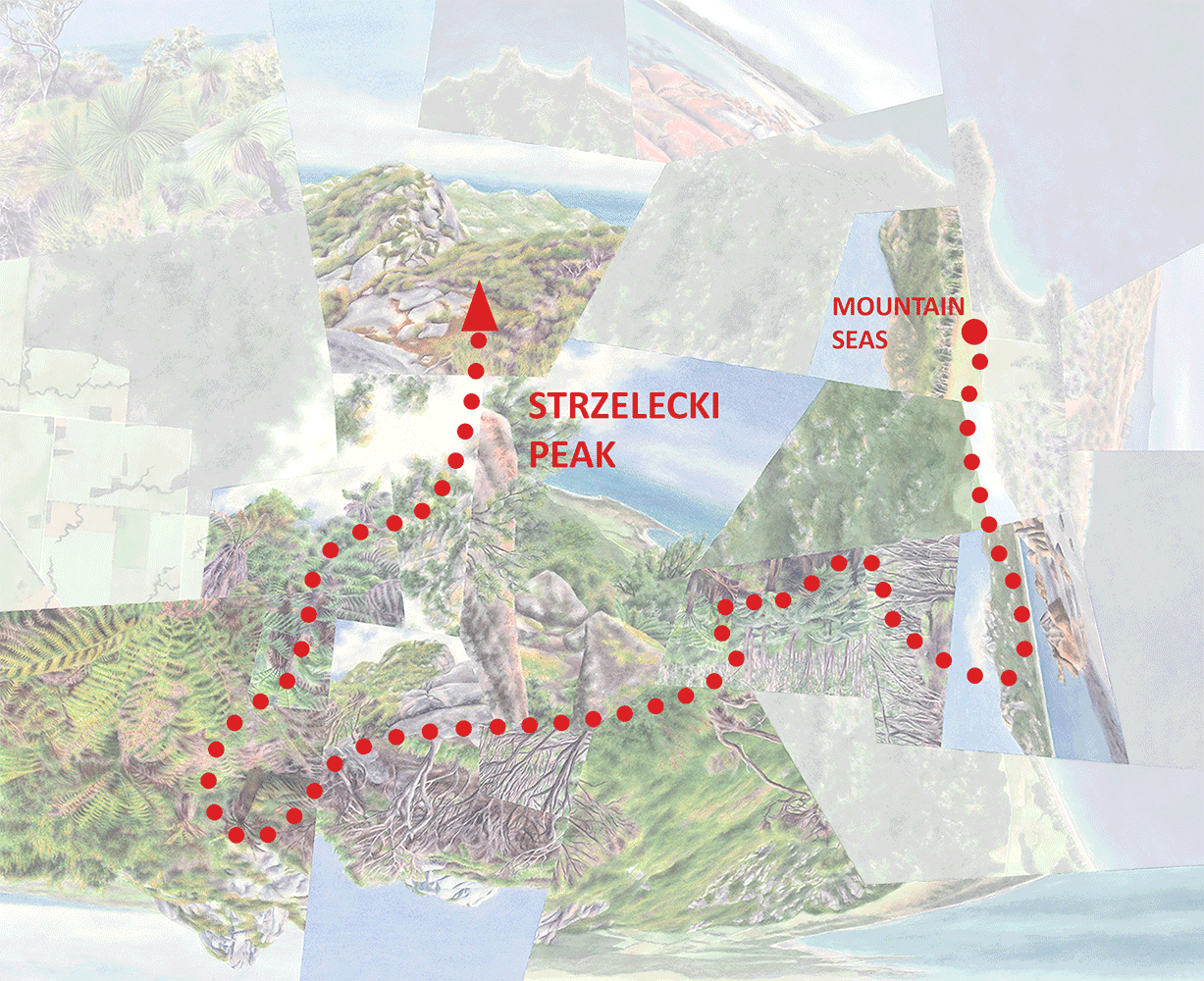I’m back to work after six weeks gathering inspiration in Chile, Bolivia and Peru! You’ll hear plenty about the trip in this blog after I’ve begun putting it on paper (my Jan. 8 newsletter gave a visual overview). For now, I’ll pick up where I left off in October with representations of islands, specifically “actual” islands surrounded by water. As I described earlier, these can be thought of as only the clearest examples of the “islands” that essentially represent all of the natural world today, in that the pieces we have left are small, isolated, and rare.
Santa Cruz Island, showing the conversion of nearly the entire highland area to agriculture.
Santa Cruz is the second-largest, and most populous, island in the Gálapagos, an archipelago best-known for its animal life but which is no less fascinating for its flora and ecology. From my own perspective its most entrancing characteristic (as you might guess) is its dramatic ecological contrasts, ranging from an arid zone at sea level to—at the highest elevations—an atmospheric, mist-fed “fern-sedge” zone too saturated to support native trees. This entire transition, originally encompassing around six habitat types, is compressed into an surprisingly small elevational range of only about 700m.
Mangroves and (in the distance on the right) Opuntia cactus forest at Tortuga Bay, Santa Cruz Island. (These photos are all from a trip in 2018, my second visit to the islands.)
The arid zone of Santa Cruz near Tortuga Bay, with giant Opuntia cactus.
The highland Scalesia zone, with forest of Scalesia pedunculata (in the daisy family).
Lower edge of the fern-sedge zone near the top of the island.
Santa Cruz, reaching 864m, incorporates this entire precipitation gradient, though as throughout the archipelago (especially on the other three populated islands) its native habitats have been heavily altered if not nearly obliterated. The arid zone is the most extensive and (being unsuitable for agriculture) the most intact, but goats and other invasive species have had significant impacts. The mid-elevation Scalesia forests have been nearly all replaced by farmland and exotic trees. And the fern-sedge zone, without native trees to compete with outsiders, has been largely taken over by forests of Cinchona pubescens (the red quinine tree).
Original (left) and current distribution of Scalesia forest, shown in red, on Santa Cruz. (From Mauchamp and Atkinson, “Rapid, recent and irreversible habitat loss: Scalesia forest on the Galapagos Islands,” Galapagos Report 2019-2010.)
Stems of dead Cinchona trees in the fern-sedge zone, killed manually through chemical control (apparently effective, but costly).
The two worldviews below are based on visits to relatively intact remnants of these landscapes, arranged (and edited a bit) to create the impression that they still extend across the entire island.
Ascent (watercolor on paper, 18”x18”), essentially an idealization of the now heavily-altered southern half of Santa Cruz.
Up (watercolor on paper, 20x23”), an idealized “overview” of the entire island.
Because the island’s highland ecosystems only remain as isolated pockets if at all, it’s no longer possible to travel the complete dry-wet transition without passing through cultivated or heavily degraded landscapes. I find that jumping from one habitat to another, without transition, paradoxically waters down the experience of the contrasts between them—they might as well be on different islands. But in the generally intact northern half of the island (all National Park land unlike much of the populated southern half) the main north-south road does at least take in part of the gradient, from the arid zone into the Scalesia zone.
Years ago, before I began creating the worldviews, my obsession was to find a way of seamlessly (through still photography) capturing a precipitation gradient like the one that originally existed on Santa Cruz. I determined that the imagery would probably turn out to be cumbersome to display and not that engaging from an artistic standpoint, but I’d still been looking for an opportunity to get the idea out of my system. Below is the result: panoramics taken at about every 30m of a total 600m elevation gain, along a taxi ride from north to south (ordered from bottom to top along the route shown on the right side).
A photographic transect across the generally intact northern half of Santa Cruz, from the arid zone into the Scalesia zone (traveling from bottom to top, north to south, sea level to highlands).
I think I was correct in expecting the product to be not particularly inspiring, particularly at this tiny scale, plus since the arid zone was relatively green at that time the contrast with the forested highlands doesn’t come across very well. (And, as you can see from the satellite view, the great majority of this half of the island is within the arid and transitional zones, while the southern half had a much greater extent and diversity of wet habitats before they were mostly cleared.) So think of it as an experiment.
On to another, nearby island in the next post!
Darren
























